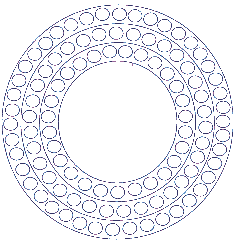Fig. 4.c
Launcher Transport Head (LTH)
pipes transported outside of the launcher
Fig. 4.a
one layer LTH from above
Fig. 4.b
multiple layer LTH from above


If the upper stage of the launcher has a diameter of 4 m and the pipe segments a diameter of about 6 cm, it is possible to transport up to 200 pipes. Given a length of about 15 m per segment youŽll get a perimeter of 3000 m from one layer. The compressed mass volume of this layer is about 0,6 cubicmeter of lightweight material. Not a weight to worry about for a big solar sailor-structure.

A multilayer LTH could transport pipes for very large ring structures.